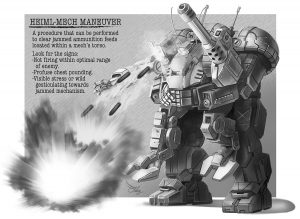Boomerang
Sarna News

- Bad ‘Mechs - Sentinel
- HEXTECH Review - Wave 3 Brings More Urban Options To Your Battlefield
- Your BattleTech News Round-Up For March, 2024
- Crashing 'Mechs With Jennifer Brozek, Author Of The Rogue Academy Trilogy
- Getting The Word Out With Rem Alternis, Catalyst Community & Marketing Director
- Read more →

| |
| Boomerang | |
| Production information | |
| Manufacturer | Cal-Boeing of Dorwinion[1] |
| Equipment Rating | |
| Use | Spotter Plane |
| Tech Base | Inner Sphere |
| Cost | 68,880[2] |
| Introduced | 2888[1][3] |
| Technical specifications | |
| Mass | 5 tons |
| Engine (Type) | GM AeroProp Turbine |
| Fuel | |
| Communications System | Achernar Air Whistler |
| Targeting Tracking System | None |
| Heat Sinks | None |
| Armament | None |
| Armor | Standard |
| Crew | 1 |
| BV (1.0) | 28[2][4] |
| BV (2.0) | 8[1] |
Contents
Description
Introduced by the Federated Suns in 2888 and named for its V-shape, the Boomerang is a typical example of the spotter planes used by the armed forces of the Successor States. It acts as a mobile spotter for artillery units and as a forward observer for advancing 'Mechs.[1][5]
Though the use of spy planes for air reconnaissance fell by the wayside upon introduction of spy satellites as far back as the twenty-first century, the massive technological decline after the collapse of the Star League returned it to its former prominence. The first aerial reconnaissance plane designed in Succession Wars era, the Boomerang's most obvious features is its long main wings, smaller forewings and large rear-mounted propeller. While resulting in an oddly proportioned plane, it makes the craft highly fuel efficient, very short takeoff and extremely maneuverable, only enhanced by the fact it can be disassembled quickly and stowed aboard even the smallest DropShip.[1][5]
The lightweight Boomerang does not have many of the computer-guided systems common to larger aircraft, which monitor the pilot's actions. A Boomerang pilot must therefore have a natural flair for flying to get the most out of the vehicle while avoiding situations where its lack of weaponry or significant armor will lead to its destruction.[1][5]
Weapons and Equipment
The Boomerang's "armament" consists of two automatic cameras working in infrared as well as standard light. The cameras see clearly even at night, enabling the Boomerang to function in all but the worst weather conditions. The two cameras can work independently, locking on to two separate targets and relaying the information back.[1][5]
Variants
The Boomerang serves as a good example of the spotter planes in use among the various Successor States, with most conforming to the same basic form and stats. Minor variants include those with multiple cameras (Draconis Combine), no cameras (Lyran Quick Dart) or even a Machine Gun firing phosphorus tracers (Free World's Chameleon).[1][5]
Notes
- In the original TRO:3025 the Boomerang was profiled as a unit constructed with the conventional fighter rules, since support vehicle rules did not yet exist at the time. As such, it had a 9/14 thrust rating. Because this is absurd while also expressly breaking rules for how fast a prop-driven aircraft can be, in TRO:3039 it was changed into a support aircraft. Key features now include a reasonable 4/6 thrust rating and the Ultralight, STOL, and Propeller-Driven chassis modifications. The Recon Camera was retained. The aircraft's cost is reduced to 46,836 and the BV remains 8.
- In German products, the unit's proper name was translated to Bumerang.
Gallery
Original Boomerang from TRO:3025
Boomerang from TRO:3025 Revised
Boomerang from AT2r



